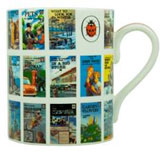
It’s not just a case of reading an excerpt and seeing if you like the person’s writing. By picking up a book, and devoting time to it, you’ve already claimed ownership. You may end up buying the book three days later on Amazon, but picking up that book in a bookstore goes a long way towards forming attachments. As it states in the article:
“The amazing part of this study is that people can become almost immediately attached to something as insignificant as a mug,” said study leader James Wolf, who began the work while he was a graduate student at Ohio State. “By simply touching the mug and feeling it in their hands, many people begin to feel like the mug is, in fact, their mug. Once they begin to feel it is theirs, they are willing to go to greater lengths to keep it.”
This is the major obstacle facing publishers: not the stigma around self-publishing, which is fading, but the inability to get a book into bookstores. This is why self-publishing advocates who claim that self-publishing is superior to traditional publishing are being quixotic. Yes, the profits are better via self-publishing, and there’s more creative control, but much of book shopping begins and ends with bookstores. Until there’s a way to find widespread distribution of self-published books in bookstores – which is not the case for the vast majority of self-published books – then self-publishing will be a second class citizen. That’s a truth self-publishers need to face.
Self-Publishing Distribution Models
There are ways around this problem. The Espresso Book Machine will print books on demand in-store. But still, this requires people to know about the book ahead of time, and if the book’s not housed on the bookstore’s shelves, this is still a struggle. So it’s progress, yes, but not a perfect solution.
Perhaps if use of the Kindle becomes more widespread (Kindle 2 comes out in February) then this could mimic this tactile feeling of ownership. The owner of an ebook reader might be able to read an excerpt of a book on the reader. It would require a different study to determine if people have the same sense of ownership for something that exists on a shared space. My guess is that, yes, there is a sense of ownership, as people are proud of their iPod collections, just as people are proud of CD collections.
The answer then would seem to be that the future of self-publishing rests in some regard on the success of the Kindle and ebook readers. At some point, bookstores may be more willing to take on self-published books, but those books will likely have to be heavily marketed like traditionally published books – i.e. not a big difference from how it is today. So even if self-publishing loses its stigma and becomes as legitimate as traditional publishing, bookstores still will not have the shelf space to house the myriad self-published books. Then again, there could come a time when Barnes and Noble has a self-publishing section. It’s not out of the realm of possibility.
Get an Editorial Review | Get Amazon Sales & Reviews | Get Edited | Get Beta Readers | Enter the SPR Book Awards | Other Marketing Services






















Leave A Comment